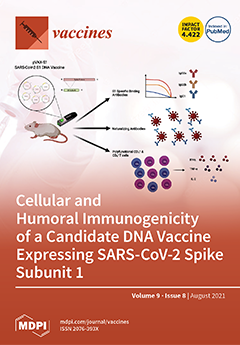Murine dendritic cells, when pulsed with heat-killed
Burkholderia pseudomallei and used to immunise naïve mice, have previously been shown to induce protective immunity
in vivo. We have now demonstrated the
in vitro priming of naïve human T cells against heat-killed
B. pseudomallei, by co-culture with syngeneic
B. pseudomallei-pulsed dendritic cells. Additionally, we have enriched the DC fraction such that a study of the differential response induced by pulsed DCs of either myeloid or plasmacytoid lineage in syngeneic human T cells was achievable. Whilst both mDCs and pDCs were activated by pulsing, the mDCs contributed the major response to
B. pseudomallei with the expression of the migration marker CCR7 and a significantly greater secretion of the proinflammatory TNFα and IL1β. When these DC factions were combined and used to prime syngeneic T cells, a significant proliferation was observed in the CD4
+ fraction. Here, we have achieved human T cell priming
in vitro with unadjuvanted
B. pseudomallei, the causative organism of melioidosis, for which there is currently no approved vaccine. We propose that the approach we have taken could be used to screen for the human cellular response to candidate vaccines and formulations, in order to enhance the cell-mediated immunity required to protect against this intracellular pathogen and potentially more broadly against other, difficult-to-treat intracellular pathogens. To date, the polysaccharide capsule of
B. pseudomallei, fused to a standard carrier protein, e.g., Crm, looks a likely vaccine candidate. Dendritic cells (DCs), providing, as they do, the first line of defence to infection, process and present microbial products to the immune system to direct downstream immune responses. Here, we have sought to use DCs
ex vivo to identify immunogenic products from heat-killed
B. pseudomallei. Using practical volumes of fresh human donor blood, we show that heat-killed
B. pseudomallei activated and stimulated the expression of pro-inflammatory cytokines TNF-α, IL-1β and IL-6 from both myeloid and plasmacytoid DCs. Furthermore,
B. pseudomallei-pulsed DCs cultured with naïve syngeneic T cells
ex vivo, induced the activation and proliferation of the CD4
+ T-cell population, which was identified by cell surface marker staining using flow cytometry. Thus, both DC subsets are important for driving primary T helper cell responses to
B. pseudomallei in healthy individuals and have the potential to be used to identify immunogenic components of
B. pseudomallei for future therapies and vaccines.
Full article






